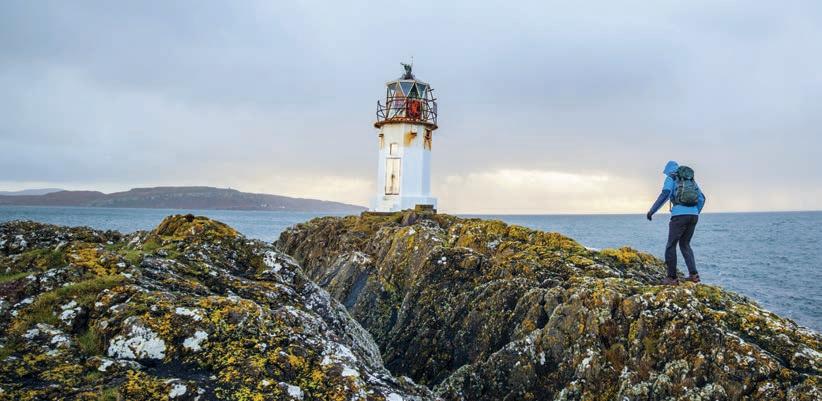
6 minute read
Firth of Clyde
ROAMIN' IN THE GLOAMIN'
Strange as it may sound, your own two feet – with a bit of help from the ferry and the bus – are perhaps the best way to navigate the Firth of Clyde, as Keith Smith explains
At almost 1500 square miles, and with the deepest coastal waters in the British Isles, exploring the Firth of Clyde by foot might seem something of an odd choice. But thanks to an extensive network of way-marked footpaths, it’s possible, with relative ease, to explore the coastlines and interiors of the peninsulas, promontories and islands that populate the Clyde waters. Many sections of the walking trails are fairly accessible, and won’t require much more than a stout pair of boots, some appropriate clothing and basic vittles to negotiate them.
On the western side of the Firth is the 100-mile-long Kintyre Way. Offering views of Islay, Gigha and the Paps of Jura, this seven-stage trail stretches from Tarbet in the north and works its way down to Southend, where the Firth of Clyde meets the Irish Sea proper, before traversing back round to Machrihanish.
From Tarbet, it’s just a short ferry hop to a slightly shorter, but no less awe-inspiring walk. Described as ‘Scotland in 57 miles’, the Loch Lomond & Cowal Way snakes across the Cowal peninsula from the dock at Portavadie up to Inveruglas on Loch Lomond.
One of the refuges of the red squirrel, along with Arran and Kintyre, the forest sections of the walk are also home to foxes, badgers and barn owls. On the coastal segments, it’s common to spot otters, seals and porpoises in the water, while further north on the open hillsides, you might see one of the area’s four pairs of golden eagles in the skies.
The splendid shell of Dunans Castle and the hidden remains of Asgog Castle can be found along the route, while at Glendaruel, Kilmodan Church is noted both for its 15th-century carved burial stones and its unusual interior layout. Legend has it that the three separate entrances, staircases and galleries were designed to ensure

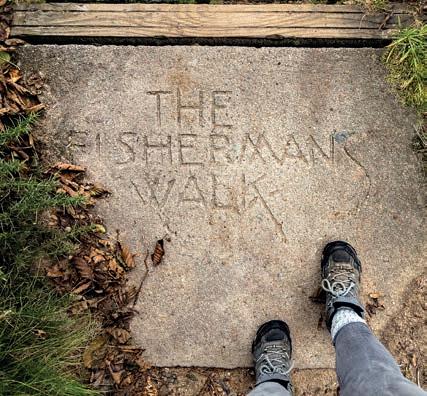
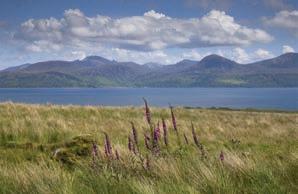
ROAMIN' IN THE GLOAMIN' (ON THE BONNIE BANKS O' CLYDE)
three local sparring Campbell families could each talk to God, without having to talk to each other.
Around the delightful village of Tighnabruaich, the Loch Lomond & Cowal Way skirts along the shores of the Kyles of Bute, across which you can virtually see some of the West Island Way – a 28-mile trail on the Isle of Bute itself. Opened in 2000, it was Scotland’s first official long-distance island pathway and is, in essence, two circular walks with a middle joining section bringing them together. Most people tend to base themselves in Rothesay, tackling the parts separately and returning to the town each night. It’s possible to complete it without doing so, of course, with some terrific wild camping opportunities for the adventurous.
The southern walk, a circuit from Kilchattan Bay, showcases some of the island's most dramatic scenery, as volcanic rock meets the power of the sea. Other highlights include St Blanes, a ruined 12th-century church, and panoramic views of Little Cumbrae, Great Cumbrae and Arran.
As the name suggests, the 63-mile long Arran Coastal Way follows the outline of the island, with minor deviations inland and the odd alternative path that can also be used to turn some of the stages into circuits. It’s challenging in places, but well worth the extra effort.
From its position in the centre of the Firth, Arran is perfectly situated to provide the most expansive view of the region. Depending on where you are (and the weather, naturally) it’s possible to see the peninsulas of Cowal and Kintyre, the Isle of Bute, much of the Ayrshire coast, Ailsa Craig and across the Irish Sea to Northern Ireland. Other offshore rewards include the chance to see bottlenose dolphins, basking sharks and minke whales.
Onshore, it’s no less interesting, from the ruins of Lochranza Castle and the neolithic Machrie Moor standing stones, to the King’s Cave, where Robert the Bruce supposedly had his famous arachnid encounter.
And if you do want to try, try and try again, then it's worth keeping in mind that the area is also the perfect gateway point for the 100-mile Ayrshire Coastal Path from Glenapp to Skelmorlie, and the 34-mile Three Lochs Way, connecting lochs Lomond, Long and Fyne.
ADVERTISING FEATURE
A Sense of CalMac Adventure
We like to think that every journey with CalMac starts a story: one full of great memories. This year we’ve teamed up with some of the best tourism operators and attractions all over the west coast to create our CalMac Adventures – a series of memorable day trips that are sure to be page-turning chapters in your CalMac story
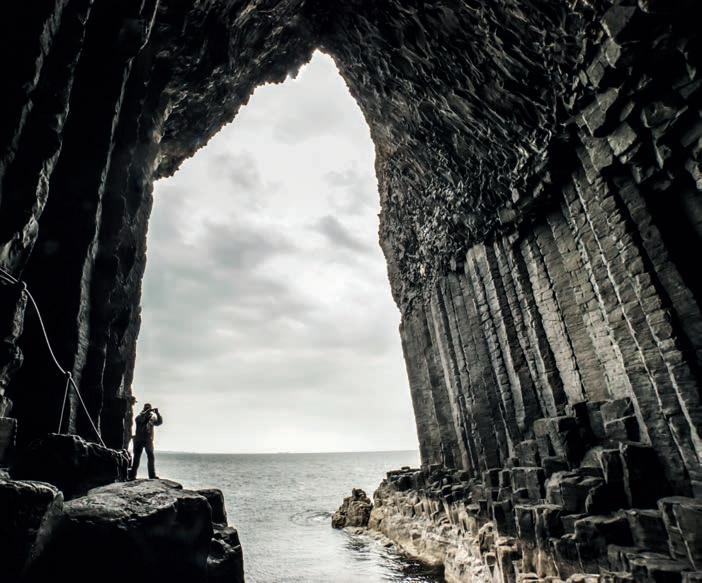
There’s something for everyone in our CalMac Adventures: they’re perfect for the history lovers, wildlife spotters and seaside explorers amongst you. A perfect combination, teaming the excitement that comes with a ferry journey to somewhere new at your own pace, or with the insight and knowledge of local guides and experts who live and breathe all this part of the world has to offer.
Treshnish Isles and Staffa A journey from Oban to the beautiful and uninhabited Treshnish Isles and Staffa. Lying just three miles off the coast of Mull, the Treshnish Isles are home to a thriving wildlife community. Cruise through the islets and rocks before docking at Lunga. From April to early August, you’ll be
ADVERTISING FEATURE
A Sense of CalMac Adventure

able to see the beautiful seabirds that frequent this part of the world – including the cheeky and characterful puffin – before setting sail for Staffa and the famous Fingal’s Cave.
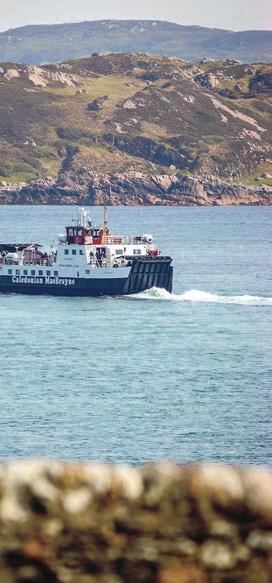
Three Isles Tour Set sail from Oban to begin this hat-trick of islands, taking in Mull, Iona and Staffa. Travel through Mull by coach where you’ll be introduced to its famous majestic landscapes, before setting sail for Staffa, home to the natural phenomenon of Fingal’s Cave and its towering basalt columns. Depending on the timing of your visit, you might also be in for a wonderful dose of puffin therapy. Finally, the island of Iona awaits: a tiny island that played a huge role in history as the cradle of Christianity in Scotland and the burial place of ancient kings, from McAlpin to MacBeth.
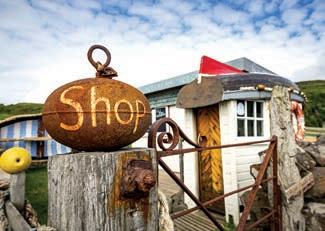
Big Bird Trip If you want to focus solely on the wildlife the west coast is famous for, our Big Bird Trip is the perfect adventure. Sailing from Oban to Mull and then out to the Treshnish Isles, you’ll have four hours to spend watching and taking in the wildlife, sights and sounds of Harp Rock Sea Stack – including guillemots, razorbills, kittiwakes, fulmars and puffins – before sailing to Staffa to see the unmissable Fingal’s Cave.
Every journey starts a story and our CalMac Adventures will help you write your best chapter yet. Find out more about our full selection at: calmac.co.uk/adventures










